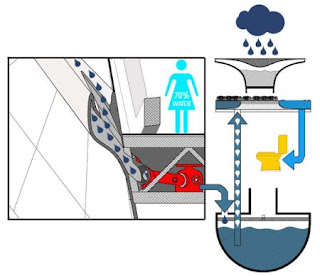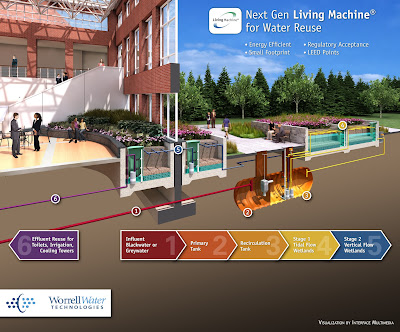Thursday, June 10, 2010
Rain Drops
Designer : Evan Gant
I like this alot :)
Conneted to a gutter, UV light filter the rain water into easily clean and storable bottles. Allows for diversity in size and location as well as it is cheap to construct.
Thursday, June 3, 2010
Home Rain Barrels
I have seen these popping up outside homes all around Portland. Standard size being around 55 gallons, these Rain Barrels hook up to your home's downspouts and can be used to water your garden and yard. I found a website selling homeowners rain barrels anywhere from 55- 3000 gallon capacity. With more and more homeowners interested in conserving water, the design will only get better. Barrels can be found any color and size and made from a variety of material; plastic, metal, wood, etc.
Shanghai Tower
The new Shanghai Tower, estimated to be done in 2014. The building is designed as nine stacking buildings on top of each other, spiraling to the top of the world. This tower features a state of the art rain harvesting system that filters water through turbines using gravity and stores it in the bottom of the building.
Within its 128-stories, Shanghai Tower contains Class-A office space, entertainment venues, retail, a conference center, a luxury hotel and cultural amenity spaces
Capture the Rain
H3AR architecture students
Bored of catching water simply on the roof? This design takes the buildings shell and allows water to be harvesting from all angles and sides. The designers estimate that the average daily consumption of water per person is about 150 liters, 85 liters may be replaced by rainwater
The Watree
Chris Buerckner
Similar to the rain pod, this rain water harvesting system can fold up and down and creates a conversion area. Designed to bloom like a tree, this canopy of umbrella like structure expands out ward to capture falling rain. The fact that this thing can open and close is really cool. I could see these are green roofs, and in the summer they are closed, maybe some ever open to create shade as well.
The Rain Water Umbrella
I saw these pictures on multiple sites but couldn't find the designer... which makes me think it might be part joke, part experiment. Either way, I think it is a great idea. Imagine walking to class and instead of just fighting off the rain, you were actually filling your own water bottle to enjoy. Most importantly this design highlights the fact that rain water is a valuable asset and not something to just stay out of.
Cool Video about Rain Water
How do we keep and share our rain water? Doesn't it belong to each of us?
This video is short, but sweet about the simply rain water harvesting that you and I can do everyday.
This video is short, but sweet about the simply rain water harvesting that you and I can do everyday.
Rain Catcher
Some of the best ideas, are the ones that never get built.
Penghao Shan
Zhejiang Sci-tech University, China, within the top 8 best Electrolux Design Lab ´09 entries.
Penghao Shan
Zhejiang Sci-tech University, China, within the top 8 best Electrolux Design Lab ´09 entries.
A students answer to the our water storage problems. These flying balls catch rain water and filter them, then bring the water straight to you for enjoyment. The balls are stored on a loading dock and are activated when the rain starts.
Think of each apartment had these on there patio. Crazy huh!
Rain Pod
Design meets function... The Rain Pod is born.
Still in conception, this rain harvesting device has the ability to collect rain and store in it a variety of scales. I like the appearance as well as the idea of being able to purchase these for personal use. Often we think of harvesting rain as a huge scale project with a big investment. This design displays how simple it can be to capture water, as well as it provides flexibility as it folds down in serve weather.
OMEGA
 Omega Center For Sustainable Living
Omega Center For Sustainable Living



BNIW Architects
Location: Rhinebeck, New York
Building trying to achieve LEED platinum as well as the Living Building Challenge guidelines. This building features :
Net zero energy use due to photovoltaic array;
Net zero water use;
High fly-ash content concrete;
Green roof;
Rain gardens;
Automatic windows to vent out hot air;
Recycled content steel throughout;
Closed-loop geothermal heating and cooling;
All construction materials are FSC certified, locally sourced, and do not contain chemicals on the Living Building Challenge’s Red List.
Building's Eco Machine, designed by Living Machine created, will handle around 5 millions gallons of waster annually.
The Living Machine
The living machine has been around for awhile now, after the late 50's when it was discovered that recreating wetland like ecosystems could filter and clean water. The living machine uses living plants and microorganisms to clean water without the heavy energy usage of standard treatment facilities.
With advances in design, these are being put everywhere in buildings and used as a focal point now. Water from this process can only be used to irrigate plants or as toilet water within the building it's housed in. Using a living machine could reduce water demand by 85%.....
Achieving Water Independence in Buildings- Report
Central City Concern, a non-profit owner of affordable housing in Portland, OR conducted this report on the barriers and benefits of net-zero water usage in buildings in response Living Building Challenge.
The report is full of information on equity issues that arise from water usage and low income housing. It also contains useful information on black and grey water, as well as provides a 9 step approach to reaching water independence.
The report is full of information on equity issues that arise from water usage and low income housing. It also contains useful information on black and grey water, as well as provides a 9 step approach to reaching water independence.
The report can be found here.
Oregon Sustainable Center
Location: Portland, Oregon
The first of it's kind yet- this high rise is trying to achieve what no other has- the Living Building Challenge standards of Net-zero energy and water consumption.
Portland's new sustainable HUB, the Center integrates under one roof sustainability-driven businesses and non-profits, university-level education and research, energy policy and planning, workforce development, and public agencies.
Center For Sustainable Landscapes
 Designed and built by the people of Pittsburgh and Pennsylvania as an innovation for the world
Designed and built by the people of Pittsburgh and Pennsylvania as an innovation for the worldLocation: Pittsburgh, Pennsylvania
 This building focuses on achieving the Living Building Challenge standards of Net zero energy and water production/consumption.
This building focuses on achieving the Living Building Challenge standards of Net zero energy and water production/consumption. rain water is stored in two 1,700 gallon underground cisterns
Rainwater will be used for toilet flushing, as well as interior irrigation and maintenance as required
 Ultra low flow plumbing fixtures include waterless urinals and dual flush toilets
Ultra low flow plumbing fixtures include waterless urinals and dual flush toilets •Water flows through a 7-step process where plants and their symbiotic root microbes absorb organic and mineral nutrients
I love that the entire community came together to design this building. Multiple architecture and engineering firms worked together to make the Living Building Challenge a reality in this community.
This property has it all from wetlands, to bio swales, and rain gardens
Lengau Lodge
Location: South Africa
Built as a family compound of nine separate buildings, this home that sits on a national wildlife refuge in South Africa is highly sustainable. The compound collects it water from the rain and treats all of it's waste on site through two outdoor adjacent wetlands.
Grey & black water from the house enters the septic tank, than gravity fed through an anaerobic rock filter and into Wetland 1 that has pond lilies and reeds. The UV light in wetland 1 kills most of the bacteria in the water before it travels through the biological filter. Next the water is split back into both wetlands 1 &2. Wetlands 2 is planted with native plants and grasses. Water eventually leaves wetland 2 to be used for irrigation purpose on the compound, as well as to a animal watering hole that is frequented by local wildlife.
There is a great drawing of the whole process if you check out Dry Designs website and look through the Lengau Lodge sustainable features. I couldn't copy it :(
Subscribe to:
Posts (Atom)










































